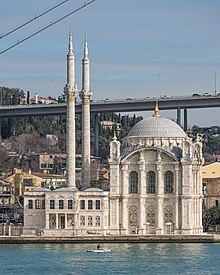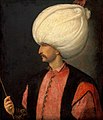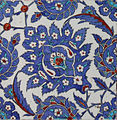Turkish art

Turkish art (
The nakkashane, as the palace workshops are now generally known, were evidently very important and productive, but though there is a fair amount of surviving documentation, much remains unclear about how they operated. They operated over many different media, but apparently not including pottery or textiles, with the craftsmen or artists apparently a mixture of slaves, especially Persians, captured in war (at least in the early periods), trained Turks, and foreign specialists. They were not necessarily physically located in the palace, and may have been able to undertake work for other clients as well as the sultan. Many specialities were passed from father to son.[2]
Seljuk period

Most Anatolian Seljuk works are of dressed stone, with brick reserved for minarets. The use of stone in Anatolia is the biggest difference with the Seljuk buildings in Iran, which are made of bricks. This also resulted in more of their monuments being preserved up to modern times.[3] In their construction of caravanserais, madrasas and mosques, the Anatolian Seljuks translated the Iranian Seljuk architecture of bricks and plaster into the use of stone.[4]
The architects that the Seljuks built during this period were of great importance in art. Seljuk structures built during the
Ottoman period



Ottoman architecture developed traditional Islamic styles, with some technical influences from Europe, into a highly sophisticated style, with interiors richly decorated in coloured tiles, seen in palaces, mosques and turbe mausolea.[5]
Other forms of art represented developments of earlier
The reign of the Ottomans in the 16th and early 17th centuries introduced the Turkish form of
Other important media were in the applied or
18th to 20th centuries
In the 18th and 19th centuries Turkish art and architecture became more heavily influenced by contemporary European styles, leading to over-elaborated and fussy detail in decoration.[11] European-style painting was slow to be adopted, with Osman Hamdi Bey (1842–1910) for long a somewhat solitary figure. He was a member of the Ottoman administrative elite who trained in Paris, and painted throughout his long career as a senior administrator and curator in Turkey. Many of his works represent the subjects of Orientalism from the inside, as it were.
20th century and onward
| Part of a series on the |
| Culture of Turkey |
|---|
 |
| Languages |
|
Folklore |
| Cuisine |
| Festivals |
| Religion |
|
Art |
| Literature |
A transition from Islamic artistic traditions under the Ottoman Empire to a more secular, Western orientation has taken place in Turkey.
Gallery
Architecture
-
Entrance of theÇifte Minareli Medrese in Erzurum(c. 1250)
-
Entrance of theDivriği Mosque, Sivas(c. 1229)
-
Imperial Hall in Harem of Topkapı Palace in Istanbul
-
Istanbul Yalı architecture
-
An example of the Yalı architecture
-
Safranbolu, an Ottoman village
-
Interior of a dome at Dolmabahçe Palace
-
Bursa Grand Mosque
-
Cross section and plan of Bayezid II Mosque, the oldest imperial complex in Istanbul that is preserved in more or less its original form
-
Exterior design of Selimiye Mosque, Edirne
-
Interior decoration of the dome of Selimiye Mosque, Edirne
-
Old Fatih Municipality Building
-
Liman Han (inn)
Calligraphy
-
Sample training of Abdul Rahman Hilmi, ink, colours and gold on paper
-
Gold illuminated two opening chapters of theMehmed Şevki Efendi
-
Illuminated first page ofAhmet Karahisari
-
Hafız Osman(1642–1698)
-
Decorated tughra ofSuleyman the Magnificent(1520)
-
A decree with royal tughra on top for appointing second imam in the Mehmed Sultan Mosque inRepublic of Macedonia
-
Main dome of the Blue Mosque with calligraphy inscriptions
-
TheTopkapi Palace, Istanbul
Carpets
-
Anatolian double-niche rug, Konya region, circa 1750–1800
-
Bergama rug
Culinary art
Dance
-
A modern Ottoman military band (mehter) troop
-
A traditional Turkish folk dance team
-
Turkish Belly Dance at the 18th International Folklore Festival, 2012, Plovdiv, Bulgaria
-
A children's folk dance team from the Black Sea region
-
Turkish dance group
-
Turkish dance group
-
ZeybekDancer
Fashion
-
Sultan Abdul Majid, Pera Museum
-
Turkish model at a fashion show, Brussels, Belgium
-
Turkish model at a fashion show, Brussels, Belgium
-
Military Pictures from the Ralamb Costume Book, 1657
-
Women's dress, late 1800s, Syria (right) and coat from early 1900s, silk and cotton (left), exhibit in the Rautenstrauch-Joest-Museum, Cologne, Germany
-
Historical Turkish costumes, 1880s, Smithsonian Libraries
-
Ashjibashi (head cook) of theJanissariesin ceremonial uniform
-
The Kul Kethüdası, commander of the third division of the Janissaries
-
Silahdar Agha, sword-bearer of the Sultan
-
A Şehzade, Ottoman prince of the blood
Handcraft
-
Minbar of theAlaeddin Mosque in Konya, dated to 1155–1156. This minbar is a prime example of the kündekâri technique, in which many interlocking pieces of wood are held together without the use of nails, pins, or glue
-
Individual pieces are carved with vegetal arabesque motifs within the wider geometric motif formed by the different pieces
-
Front part of Alaeddin Mosque's minbar
-
The carved wood minbar of the Divriği Great Mosque and Hospital in Sivas, an example of Seljuk handicraft
-
Detail of the Divriği minbar: the lines between the wooden boards mounted side-by-side are visible, while the surface itself is carved with motifs imitating kündekâri work
-
Minbar of the Great Mosque of Siirt (13th century), now housed in the Ethnography Museum of Ankara
-
Stained glass windows at Topkapı Palace
-
A room at Topkapı Palace, carpet with a small-pattern "Holbein" design
Illumination
-
Single-volume Qur’an. Copied by Khalil Allah ibn Mahmud Shah, illuminated by Muhammad ibn Ali
-
Page from Ottoman Qur'an. Ink, color, and gold on paper. Probably Edirne
-
Hilye-i Şerif Anthology, early 19th century in Sadberk Hanım Museum
-
Qur'an copied by Abdullah Zühdi
-
The name 'Muhammad' is written in mirrored thuluth script, and filled with Qur'anic verses in ghubar
-
Hilye-i Şerif. Unknown, Ottoman, circa 1725 in Sadberk Hanım Museum
-
"Divan-i Muhibbi",Calligraphy in nastaliq by Mehmed Şerif, illumination by Kara Memi, Istanbul, 1566
Miniature
-
An Ottoman official miniature
-
Miniature depiction of theBattle of Mezőkeresztes, Hungary (1596)
-
Capture of Buda (1526)
-
Miniature depicting the Siege of Nice, France (1543) by Matrakçı Nasuh
-
16th century map of Miyaneh by Matrakçı Nasuh
-
Selim II ascends to the throne
-
Topkapı Palace during the reign of Selim I
-
Use of fireworks during the celebrations.
-
Acrobats during celebrations
-
Ships of parade
Painting
-
Two Musician Girls by Osman Hamdi Bey
-
The Tortoise Trainer by Osman Hamdi Bey, 1906
-
Work by Osman Hamdi Bey
-
Arzuhalci by Osman Hamdi Bey
Sculpture
-
Güzel İstanbul by Gürdal Duyar
-
Akdeniz by İlhan Koman
-
Water Swirl by İlhan Koman
-
Statue of Humanity by Mehmet Aksoy
-
Efenin Aşkı by Hüseyin Gezer
Tiles
-
Cem Sultan tomb in Bursa, the first official capital of the Ottoman Empire
-
Tiles of theTopkapi Palace
-
Tiles of the circumcision room at Topkapi Palace
-
The entrance to the Harem at Topkapi Palace
-
Eunuchs' Courtyard in Harem of Topkapı Palace
-
Tile decoration on theSultan Suleiman's reign
-
Tiles of the Rüstem Pasha Mosque
-
Tiles of the Rüstem Paşa Mosque
-
Tiles of the Rüstem Paşa Mosque
-
Nicea) tiles
-
Iznik (ancient Nicea) tiles
-
Tiles of the Imperial Council Second Courtyard
Weapons
-
An Ottoman horse archer
-
Ottoman Mamluk horseman with mail and plate armour, 1550
-
Jeweled Ottoman sabres
-
Kilij sword was in use from the early 17th century, for more than 300 years, well into the 20th century.
-
Ottomanyataghansword, 19th century or earlier.
-
Decorated Ottoman cannon, 1581
-
Ottoman rifles, 1750-1800
See also
- Turkish and Islamic Arts Museum
- Culture of the Ottoman Empire
- Ottoman clothing
- Islamic calligraphy
- List of Ottoman calligraphers
- History of Modern Turkish painting
- Turkish women in fine arts
Notes
- ^ Levey, 12; Rogers and Ward, throughout, especially 26–41
- ^ Rogers and Ward, 120–124; 186–188
- ^ Hattstein & Delius 2011, p. 371.
- ^ Blair & Bloom 2004, p. 130.
- ^ Levey, throughout
- ^ Levey, 54, 60; Rogers and Ward, 29, 186; Rawson, 183–191, and see index
- ^ Levey, see index; Rogers and Ward, 59–119
- ^ Rogers and Ward, 55–74
- ^ Levey, see index; Rogers and Ward, 26–41, 62–64 on tughra
- ^ Rogers and Ward, 120–215, cover a wide range; Levey, 51–55, and see index
- ^ Levey, chapters 5 and 6
References
- Blair, Sheila; Bloom, Jonathan (2004). "West Asia:1000-1500". In Onians, John (ed.). Atlas of World Art. Laurence King Publishing.
- Hattstein, Markus; Delius, Peter, eds. (2011). Islam: Art and Architecture. H. F. Ullman. ISBN 9783848003808.
- ISBN 0500270651
- ISBN 0714114316
- Rogers J.M. and Ward R.M.; Süleyman the Magnificent, 1988, British Museum Publications ISBN 0714114405
Further reading
- Binney, Edwin. Turkish Miniature Paintings and Manuscripts, from the Collection of Edwin Binney, 3rd. New York City: Metropolitan Museum of Art; Los Angeles, Calif.: Los Angeles County Museum of Art, 1973. 139 p., amply ill. (in b&w). N.B.: Catalogue of an exhibition held at the named museums. ISBN 0-87099-077-2
- Miller, Lenore D. Echoes of Anatolia: Works of Contemporary Turkish-American Artists ... [catalogue of an] Exhibition [which] Has Been Realized through the Generosity of the Contributing Artists and [of] the Turkish Embassy in Washington, D.C. [Washington, D.C., c. 1987]. 24 p., amply ill. (in black and white). Without ISBN








































































































